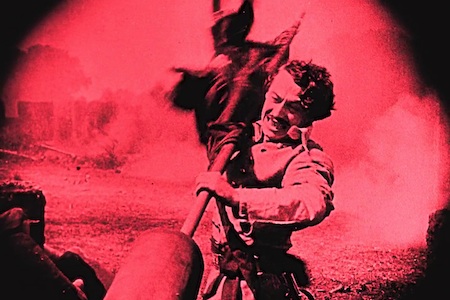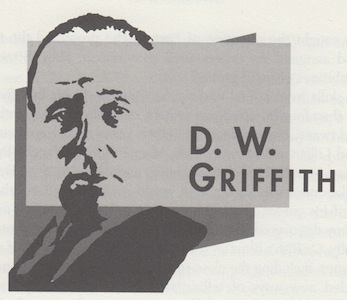Born: January 22, 1875, Floydsfork, KY
Died: July 23, 1948, Hollywood, CA
We regarded him as a leader; and I think the leader of our whole business. We’ve never had a leader since.
—Allan Dwan
As a child, David Wark Griffith was mesmerized by his father’s tales of the Mexican wars and readings of Dickens and Shakespeare. Nineteenth century literary works further fascinated Griffith while working as a clerk in a Louisville bookstore around 1890. Exposed to the local poets and community theater actors, Griffith became fixated on adapting Elizabethan poetry to the stage. He began acting in amateur groups and received a professional position in the stock company of the Temple Theatre, where he wrote some plays without attribution. But the sale of some of his scenarios to pioneer Edwin S. Porter in 1907 changed the course of his life. In a letter to Porter, Griffith expressed admiration for the influential editing techniques that he had seen in The Great Train Robbery (1903). Flattered, Porter offered Griffith a job as an actor at Biograph in New York.
Narrative structure had been left largely unexplored by the Biograph staff; most directors were merely cameramen with seniority, so their films were generally straightforward recordings of poorly acted vignettes. Porter, who knew this, saw in Griffith a man with stage experience, a sense of the dramatic and, best of all, no mechanical aptitude. Griffith proved to be a rather gawky and inanimate actor for silent films, but his suggestions for improving productions caught the attention of Porter, who promoted the thespian to director and assigned an experience cameraman, Billy Bitzer, to keep Griffith’s ambitions on solid ground.
Griffith’s skills were honed under a hectic pace. In his first five years, he made more than four hundred one-reelers, each about twelve minutes long. He averaged twenty-one productions a week, using a stock company of actors that included Lillian and Dorothy Gish, Mary Pickford, Blanche Sweet, Mack Sennett, Mae Marsh, Lionel Barrymore and Harry Carey. However, his greatest collaborator was Bitzer, who would remain with Griffith for almost every film of his career and held a unique role as confidant and mentor. Together, they discovered film language through experimentation.
Technically, Griffith’s films were ambitious. His refinement of motion picture techniques, including the close-up, the long shot, panning and cross-cutting, provided new ways of telling stories. He continually used parallel plotlines and cut between the different stories; audiences who watched A Corner in Wheat (1909) or The Lonely Villa (1909) were often confused by such back-and-forth storytelling. But Griffith’s films contained such raw emotional impact that unsophisticated moviegoers overlooked these faulty trials.
His successes piled up, and Griffith became the first director to establish a following among theater patrons, largely due to his thematic choices. Although his stories were largely based on the melodramas he admired as a young man, Griffith’s movies were a vital bridge between antiquated Victorian values and the blinding modern age as he focused on issues of inhumanity and social injustice in modern society. Foreign filmmakers soon duplicated his scenarios, and the entire world was taking in the subjects that Griffith alone conceived. By 1913, he was an international celebrity, commanding absolute rule over his productions.
At this time, two crucial developments in the motion picture industry would crystallize Griffith’s reputation: studios instituted a division of labor among its staff and placed its craftsmen in units, and unions responded by organizing around these new trades. Gone were the days when the camera could be cranked by anyone willing and able. Suddenly, a cameraman was a cameraman. A stuntman was only a stuntman. And a director was exclusively a director. Each specialized field had its heroes, and Griffith became the quintessential director. Many of the stereotypical conventions of the Hollywood director were modeled after his eccentricities: shouting instructions to actors through a megaphone; giving direction from a folding chair; wearing flamboyant hats and riding pants to the set; throwing temper tantrums; handing down orders to set crews through assistants; using experts to lend authenticity to scenery and costumes. The position has never escaped these influences.
In 1913, Griffith fervently debated with Biograph executives over the running time of The Massacre. The fighting drove Griffith from the company. Interested only in feature-length films, he joined Reliance-Majestic studio and prepared in secrecy for The Birth of a Nation (1915) with only Bitzer as a conspirator.
The release of The Birth of a Nation brought Griffith more infamy than acclaim. President Woodrow Wilson originally praised it, then succumbed to pressure and denounced its racial violence. Banned in eight states, it was cut and censored by other theater owners. Even audiences sensitive to Griffith’s casual depiction of the Ku Klux Klan were startled by the force of the epic. Most films had only a hundred different shots in their entirety, but Birth consisted of 1,544. In all, more than three million people came to see the battle sequences and historical re-creations, making it the most popular film up to that time. Filmed for under $125,000, it netted profits in the millions. Sergei Eisenstein, Cecil B. DeMille and Fritz Lang cited it as a major influence. However, Griffith was angered by the critics’ outcry of racism. He campaigned against the dangers of censorship and extolled the role of the director as visionary.
He hurried to finish Intolerance (1916) as an answer to his doubting public. Wrapping four historical stories around the theme of man’s inhumanity, Intolerance was both an artistic achievement and a huge flop. Of its four interwoven stories, only one had a happy ending. Audiences were perplexed by the quartet of battle sequences, and the torrent of overlapping images was mind-boggling. To salvage his spiraling losses, Griffith yanked the film from theaters after a short twenty-two weeks and cut the Babylonian scenes into separate features, The Mother and the Law and The Fall of Babylon (1919). The Intolerance editing style was not completely wasted, however; Eisenstein and others recalled it as brilliant and inspirational.
In 1919, Griffith joined Mary Pickford and Charlie Chaplin in forming United Artists, a corporation that would allow him even greater control over his work. He settled into his craft and made some of his more palatable features, including Way Down East (1920), Orphans of the Storm (1922) and Isn’t Life Wonderful (1924), a forerunner to the location shooting style of Vittorio De Sica’s neorealist “street” films. Griffith’s final film was The Struggle (1931), a haunting story of alcoholism that tackled taboos Hollywood would repress for another thirty years. After only two talkie efforts, Griffith retreated from the film industry disheartened and unfulfilled. In his later years, he became a symbol of the passing silent era and was shunned by the new blood in Hollywood. After spending more than a decade in isolation at the Hollywood Knickerbocker Hotel, he died in 1948.
Celebrated as one of the century’s great renaissance men, D.W. Griffith was the first ideal of the film director. His presence can still be seen in the working methods of contemporary directors. The camera techniques and basic narrative structure of every film made today contain fundamental elements that he first explored nearly a century ago. In a career that spans almost 550 films, Griffith took the existing techniques of moviemaking and turned them into a “grammar” of film.
To read all the republished articles from ‘The Film 100,’ go to Reintroducing the Film 100 here on Keyframe.





